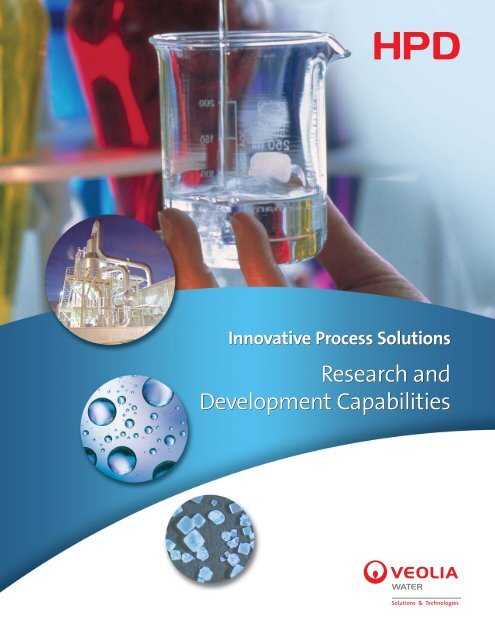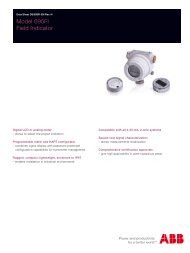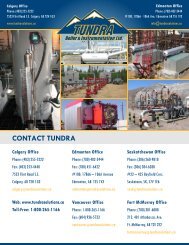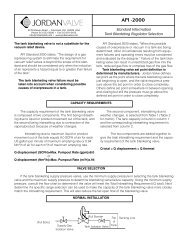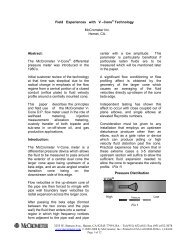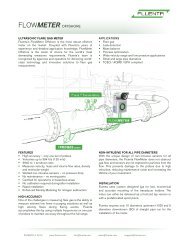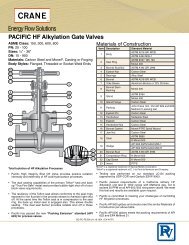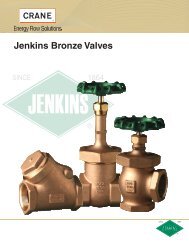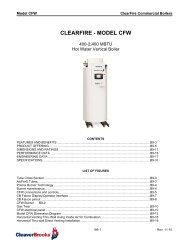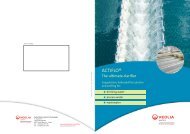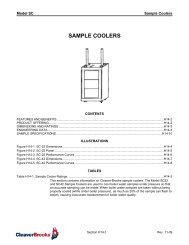HPD R&D BROCHURE 9-24:Layout 1 - Veolia Water Solutions ...
HPD R&D BROCHURE 9-24:Layout 1 - Veolia Water Solutions ...
HPD R&D BROCHURE 9-24:Layout 1 - Veolia Water Solutions ...
You also want an ePaper? Increase the reach of your titles
YUMPU automatically turns print PDFs into web optimized ePapers that Google loves.
Innovative Process <strong>Solutions</strong><br />
Research and<br />
Development Capabilities
Research and Development<br />
Direct Results<br />
Ethanol / Biofuels Industry<br />
<strong>HPD</strong>’s research and development center has performed<br />
several key demonstrations of Enhanced Forced Circulation<br />
Technology in the development of the High Efficiency<br />
Stillage Concentration (HESC) system for the renewable<br />
fuels industry. These tests confirmed design parameters<br />
and concentration limits for stillage (syrup) in the<br />
production of co-products in corn-based ethanol facilities.<br />
The HESC system was designed as an intermediary step to<br />
increase solids between the falling film evaporators and<br />
gas-fired dryers for more efficient water removal in the<br />
production of DDGS (distillers dried grain with solubles).<br />
A critical characteristic of the process stream is the high<br />
viscosity experienced at higher product solids. Standard<br />
evaporative processes, such as falling film evaporation,<br />
often experience difficulties in reaching higher total solids<br />
(above 30%TS) due to reduced heat transfer and excessive<br />
fouling as a result of increased stillage viscosity. The HESC<br />
system’s unique heat transfer technology was developed to<br />
address the need for higher concentrations in these highly<br />
viscous streams while minimizing system fouling.<br />
Bench-scale and pilot-scale testing confirmed that the<br />
HESC system will achieve concentration levels<br />
exceeding 50% total solids with minimal fouling. More<br />
importantly, the testing demonstrated that the system<br />
will reduce energy consumption in the process with<br />
annual savings of over $2,000,000 in natural gas usage<br />
for water removal in a typically sized plant.<br />
Mining Industry: Lithium Chloride<br />
– Argentina<br />
<strong>HPD</strong> developed a process design for production of both<br />
high-purity lithium chloride monohydrate and anhydrous<br />
lithium chloride (catalyst grade). The Research and<br />
Development Group at <strong>HPD</strong> performed an extensive<br />
laboratory bench-scale crystallization program to determine<br />
crystallization growth kinetics and the subsequent<br />
equipment design to meet production requirements.<br />
Laboratory testing resulted in an extremely accurate<br />
prediction of achievable crystal size. More importantly, the<br />
use of bench-scale testing allowed <strong>HPD</strong> to directly translate<br />
the findings from the laboratory to a successful,<br />
commercially proven crystallization system.<br />
2
Industry Leadership Through R&D<br />
<strong>HPD</strong> maintains its market leadership in evaporation and<br />
crystallization systems based on providing innovative process<br />
solutions and technological excellence. This can only be<br />
achieved by a thorough understanding of the diverse group of<br />
industries and customers served.<br />
Research and development plays a critical role in delivery of<br />
the solutions that customers expect from <strong>HPD</strong>. Complex<br />
process designs and the establishment of new technologies in<br />
commercial applications require this high degree of<br />
preliminary evaluation and testing.<br />
Whether driven by specific customer requirements or<br />
introducing new technologies to the market, <strong>HPD</strong>’s research<br />
center provides the necessary foundation for design feasibility<br />
and accurate process validation.<br />
The Philip J. Stewart Technology Center,<br />
located on the campus of <strong>HPD</strong>, is a state-ofthe-art<br />
research and development facility,<br />
dedicated to providing industry leading<br />
support for evaporation and crystallization<br />
applications.<br />
This 50,000+ square foot complex is home<br />
to a wide variety of tools used for the<br />
investigation new of process designs,<br />
testing to support customer projects, and<br />
development of new technologies.<br />
The comprehensive in-house capabilities,<br />
unmatched variety of equipment, and the<br />
breadth of experience<br />
differentiate <strong>HPD</strong> in the<br />
industry and directly<br />
contribute to the success of<br />
over 650 installations<br />
worldwide. Decades of<br />
extensive cataloging of<br />
physical / chemical pilot<br />
evaluations and critical design<br />
data supplies an unparalleled<br />
knowledge base for future<br />
system designs.<br />
“Instrumental in this project was <strong>HPD</strong>’s<br />
pilot testing in their research facilities and<br />
the subsequent supply of monohydrate<br />
and bicarbonate crystallizers that serve as<br />
the heart of the production process.”<br />
The Philip J. Stewart Technology Center on the<br />
<strong>HPD</strong> Campus Plainfield, IL, U.S.A.<br />
Charlie Yates<br />
COO and V.P.<br />
American Soda, L.L.P.<br />
3
From the Laboratory to Commercial Success<br />
Results from the research and testing center often allow the process engineering team to improve<br />
or economize system designs. Testing provides <strong>HPD</strong> and the client with the technical confidence required to<br />
commercialize a system knowing the process objectives will meet or exceed expectations. The subsequent<br />
performance guarantees for each project then become the standard in measuring performance of the<br />
installed system.<br />
<strong>HPD</strong> researchers and process design engineers, as a team, collaborate on each project. This ensures all<br />
critical aspects of the system are supported by the results from the many methods of laboratory analysis<br />
available. This approach provides accurate and thorough information to facilitate customer approval of<br />
large, complex projects.<br />
Analytical Testing<br />
The range of in-house analytical capabilities at <strong>HPD</strong> is critical to<br />
understanding the project chemistry and its impact on the subsequent<br />
process design. Analysis of customer samples is generally the basis<br />
which supports all other phases of evaluation.<br />
The following array of analytical tests are routinely performed at<br />
<strong>HPD</strong>’s Research and Development Center:<br />
> Atomic absorption<br />
> Gas chromatography<br />
> Rheometry<br />
> Inductive coupled plasma<br />
> Total organic carbon<br />
> Crystal size distribution<br />
> Polarized light microscopy<br />
> Wet chemistry / gravimetric procedures<br />
Bench-Scale Testing<br />
An in-depth understanding of each customer’s chemistry is critical to ensure<br />
that each unique system will perform as designed. <strong>HPD</strong>’s bench-scale testing<br />
provides excellent characterization of specific chemical behavior and often<br />
reveals the necessary information required to transition directly to a<br />
commercial design. Some of the characteristics determined during benchscale<br />
testing are:<br />
> Condensate quality<br />
> Boiling Point Rise (BPR)<br />
> Foaming or fouling tendencies<br />
> Crystal size and habit data<br />
> Crystal purity versus mother liquor contaminant concentration<br />
> Characteristics of crystal impurities<br />
> Vapor/liquid equilibrium data<br />
> Physical properties (specific gravity, viscosity, specific heat)<br />
> Solubility and phase diagrams<br />
> Crystal habit modification<br />
> Crystallization kinetics<br />
Bench-scale evaporator and crystallizer<br />
4
Mini-Works<br />
<strong>HPD</strong> maintains a wide range of smaller-scale equipment that effectively<br />
predicts fouling potential, investigates heat transfer performance, and<br />
measures fluid dynamics. Testing at this scale is particularly useful for<br />
greenfield projects where there is a limited amount of samples available<br />
for full-scale evaluation or when shipping limitations are a concern.<br />
Mini-Works PIC crystallizer<br />
(Partitioned Internal Circulation crystallizer)<br />
Pilot Scale Testing<br />
Design Validation with Confidence<br />
<strong>HPD</strong>’s pilot testing capabilities provide a proving ground for each system<br />
during project development. A wide array of large-scale evaporators and<br />
crystallizers can be used to test and validate process solutions designed for<br />
commercial stage production.<br />
The pilot test setup utilizes ancillary equipment found in a full system to<br />
replicate a commercial installation and provides thorough identification of<br />
potential upstream and downstream issues. This unique capability is also<br />
an excellent tool for determining possible performance enhancements and<br />
evaluation of cost-effective approaches to the process.<br />
Specific objectives for pilot-scale tests may include:<br />
> Obtaining heat transfer data to ensure optimum design<br />
> Determination of the expected fouling rate during commercial operation<br />
> Producing sufficient amounts of commercially pure product for distribution<br />
to potential end customers for determination of its market value<br />
> Establish the amount of purge required to achieve the desired purity<br />
> Verify the viscosity of solutions at various concentrations versus temperature<br />
> Determining the impact of wash water quantity on crystal purity<br />
> Verify product control stability<br />
A Pilot-scale Enhanced Forced<br />
Circulation Crystallizer is used to<br />
fully validate heat transfer<br />
efficiency, fouling characteristics,<br />
and reduced energy consumption<br />
Case Study - Research to Commercial Success<br />
<strong>HPD</strong>’s Enhanced Forced Circulation Crystallizer, designed to address problems<br />
associated with the concentration of highly viscous products, is one of the many<br />
achievements from the Research and Development group.<br />
New process designs and rigorous testing confirmed that the Enhanced Forced<br />
Circulation technology reduced energy consumption by 50% and increased heat<br />
transfer efficiency over 100% versus standard forced circulation designs and<br />
maintained minimal system fouling.<br />
This innovation has been successfully implemented through commercial<br />
installations in the pulp and paper industry for processing black liquor and for<br />
concentration of stillage in the generation of co-product in the ethanol market.<br />
Pilot-scale Enhanced Forced Circulation<br />
Crystallizer used to fully validate heat transfer<br />
efficiency, fouling characteristics and reduced<br />
energy consumption<br />
5
From the Laboratory to Commercial Success<br />
Mobile Test Equipment<br />
Pilot-scale evaporators and crystallizers are available that can be used for on-site<br />
system testing at customer facilities. These mobile units are skid-mounted and<br />
designed to be customized for a variety of applications. Field pilot-testing is<br />
especially beneficial when:<br />
> Long-term fouling is a concern<br />
> Feed chemistry varies considerably over time<br />
> The shipment of feed material is not feasible<br />
> Production samples are desired for marketing purposes<br />
> Operator training is necessary prior to commercial installation<br />
The Field Service Group at <strong>HPD</strong> is dedicated to providing a variety of field pilot<br />
services. These services range from equipment rental with training of customer<br />
staff to complete <strong>24</strong> hour per day monitoring and operation by <strong>HPD</strong> personnel.<br />
The Service Group will typically provide complete data analysis and interpretation<br />
of pilot results in a formalized report.<br />
Mobile forced<br />
circulation crystallizer<br />
Corporate Commitment to Research<br />
<strong>HPD</strong>, as a part of the <strong>Veolia</strong> <strong>Water</strong> group of companies, mirrors the commitment to<br />
research and development demonstrated throughout the organization.<br />
Based at Maisons-Laffitte, just outside Paris, “Anjou Recherche” is the research<br />
center for <strong>Veolia</strong> <strong>Water</strong>. It replaced the historic laboratory set up in 1889 at the<br />
Group’s headquarters at rue d’Anjou in Paris.<br />
Opened in 1982, it currently is staffed by 110 researchers. Research focuses<br />
primarily on the water sector (production and distribution of drinking water)<br />
and wastewater (treating municipal and industrial wastewater, odor control). As<br />
a globally focused group, <strong>Veolia</strong> <strong>Water</strong>’s Anjou Research Center works in<br />
partnership with more than a hundred ministries/government agencies, universities<br />
and institutions in France, Germany, Great Britain, Canada and the United States.<br />
<strong>Veolia</strong> <strong>Water</strong>'s Anjou<br />
Research Center<br />
6
Research and Development<br />
Direct Results<br />
Soda Ash Industry: Monohydrate<br />
– North America<br />
<strong>HPD</strong> performed bench-scale evaporative crystallization of<br />
sodium carbonate and sodium bicarbonate from solution<br />
mining of nacholite deposits. Crystal habit, crystal shape<br />
and crystal size distribution were also verified.<br />
Crystallization testworks included both bench-scale and<br />
pilot-scale tests. Pre-concentration analysis confirmed the<br />
decomposition rate of bicarbonate and the need for more<br />
complete stripping upstream of the crystallization system.<br />
Sodium carbonate crystallization confirmed commercial<br />
system design parameters and that crystal purity<br />
requirements could be achieved.<br />
<strong>HPD</strong> constructed a sodium bicarbonate crystallizer<br />
specifically for the purposes of the comprehensive testing<br />
for the soda ash manufacturer. The new pilot-scale unit<br />
confirmed the complex process design of sodium<br />
bicarbonate crystallization. Critical process elements such<br />
as operating temperature, CO 2 utilization, equipment<br />
design parameters, and achievable crystal size and habit<br />
were revealed utilizing the new testing equipment.<br />
Mining Industry: Nitrates – Chile<br />
<strong>HPD</strong>’s Research team performed bench-scale leaching and<br />
cooling crystallization testing that aided in the final process<br />
solution for the production of sodium and potassium<br />
nitrate from Chilean caliche ore. The study involved a<br />
complete process flowsheet simulation from heap leaching<br />
caliche (nitrate ore) with sea water, solar evaporation of the<br />
leachate, harvesting the crystallized salts from the solar<br />
ponds, hot leaching the harvest salt with heated brine, to<br />
cooling crystallization of sodium nitrate.<br />
Results from the laboratory testworks confirmed the<br />
feasibility of the process and satisfied the customer that a<br />
commercial system could be designed and built without<br />
further pilot testing. The commercial performance was as<br />
projected from the test work.<br />
7
USA<br />
23563 W. Main Street, IL Route 126<br />
Plainfield, IL 60544<br />
Tel.: 815-609-2000<br />
Fax: 815-609-2044<br />
SPAIN<br />
Avenida de Neguri, 9 - 1˚<br />
48992 Getxo<br />
Tel.: +34 94 491 40 92<br />
Fax: +34 41 491 11 40<br />
www.hpdsystems.com<br />
<strong>HPD</strong>.info@veoliawater.com<br />
<strong>HPD</strong>-BR-R&D-0908


